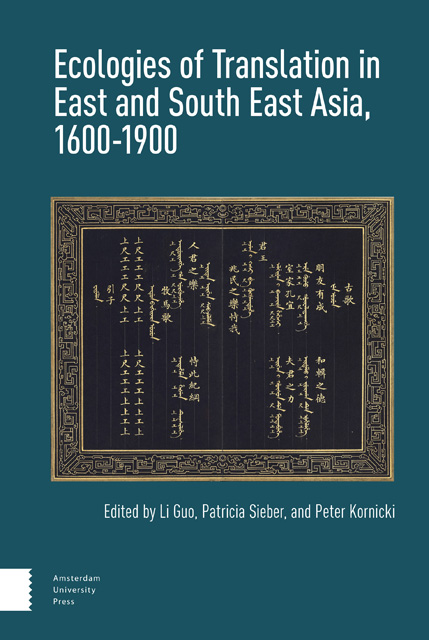Book contents
- Frontmatter
- Table of Contents
- Introduction: Scriptworlds, Vernacularization, and Shifting Translation Norms
- 1 On Not Being Shallow: Examination Essays, Songbooks, and the Translational Nature of Mixed-Register Literature in Early Modern China
- 2 A Faithful Translation: Tsūzoku sangokushi, the First Japanese Translation of Sanguozhi yanyi
- 3 Romance of the Two Kingdoms: Okajima Kanzan’s Chinese Explication of ‘The Annals of Pacification’ (Taiheiki engi)
- 4 Speaking the Sinitic: Translation and ‘Chinese Language’ in Eighteenth-Century Japan
- 5 ‘Body Borrowed, Soul Returned’: An Adaptation of a Chinese Buddhist Miracle Tale into a Vietnamese Traditional Theatrical Script
- 6 ‘Out of the Margins’: The Western Wing Glossarial Complex in Late Chosŏn and the Problem of the Literary Vernacular
- 7 Vernacular Eloquence in Fiction Glossaries of Late Chosŏn Korea
- 8 Imagined Orality: Mun Hanmyŏng’s Late Nineteenth-Century Approach to Sinitic Literacy
- 9 Linguistic Transformation and Cultural Reconstruction : Translations of Gorky’s ‘Kain and Artem’ in Japan and China
- Index
5 - ‘Body Borrowed, Soul Returned’: An Adaptation of aChinese Buddhist Miracle Tale into a VietnameseTraditional Theatrical Script
Published online by Cambridge University Press: 16 November 2022
- Frontmatter
- Table of Contents
- Introduction: Scriptworlds, Vernacularization, and Shifting Translation Norms
- 1 On Not Being Shallow: Examination Essays, Songbooks, and the Translational Nature of Mixed-Register Literature in Early Modern China
- 2 A Faithful Translation: Tsūzoku sangokushi, the First Japanese Translation of Sanguozhi yanyi
- 3 Romance of the Two Kingdoms: Okajima Kanzan’s Chinese Explication of ‘The Annals of Pacification’ (Taiheiki engi)
- 4 Speaking the Sinitic: Translation and ‘Chinese Language’ in Eighteenth-Century Japan
- 5 ‘Body Borrowed, Soul Returned’: An Adaptation of a Chinese Buddhist Miracle Tale into a Vietnamese Traditional Theatrical Script
- 6 ‘Out of the Margins’: The Western Wing Glossarial Complex in Late Chosŏn and the Problem of the Literary Vernacular
- 7 Vernacular Eloquence in Fiction Glossaries of Late Chosŏn Korea
- 8 Imagined Orality: Mun Hanmyŏng’s Late Nineteenth-Century Approach to Sinitic Literacy
- 9 Linguistic Transformation and Cultural Reconstruction : Translations of Gorky’s ‘Kain and Artem’ in Japan and China
- Index
Summary
Abstract
This chapter explores the adaptation of a ChineseBuddhist miracle tale into a traditionaltheatrical script in Vietnam in the nineteenthcentury. Contrary to the current assumption thatthe play Trương theButcher performed in Buddhist ceremoniesderives either from literary Sinitic novels orfolktales of Vietnam, this chapter argues that theproximate source for this play was a Chinesemiracle tale entitled ‘Zhang Yin’ (from around theeleventh century), associated with the spread ofthe Diamond Sutra.By discussing the similarities and differences ofthe original Chinese version and its Vietnameseadaptation, this chapter contributes to theresearch on the ecologies of translation ofChinese popular literature into the Vietnamesetheatrical corpus, particularly those associatedwith Buddhist practices.
Keywords: translation, miracle tale,theatrical script, Buddhist practices, Diamond Sutra
Introduction
Tuồng (also calledHát bội) is a formof traditional theater that was widespread incentral and southern Vietnam from the eighteenthcentury onward, reaching the height of itspopularity in the nineteenth century. It began todecline in popularity in the early twentiethcentury, partly owing to the appearance of Cải lương (Reformed theater)in the 1920s and, later, the introduction of otherforms of entertainment such as popular music andcinema. From a comparative perspective, Tuồng is a subgenre withintraditional East Asian drama along with traditionalChinese dramatic genres such as Yueju 粵劇 (Cantonese Opera) and Chaoju 潮劇 (Chaozhou Opera)as well as Japanese Noh 能 (Noh theater). The scripts ofclassic Tuồng arewritten in (chữ)Nôm (𡨸) 喃, thelogographic writing system of the Vietnameselanguage, which dates back to the fourteenth centuryat the latest and was used until the early twentiethcentury. Some of the themes in Tuồng plays are of indigenous origin andinvolve the transformation of local sources such asfolktales and legends of the supernatural, but otherplays display foreign literary influences from Mingand Qing historical fiction, Chinese scholar-beautyromance novels, French novels, as well as Chineseand Indian religious (mainly Buddhist) tales.
Tuồng, like many othertypes of traditional theatrical performance in theworld, arose in the context of religiousrituals.
- Type
- Chapter
- Information
- Ecologies of Translation in East and South East Asia, 1600-1900 , pp. 145 - 174Publisher: Amsterdam University PressPrint publication year: 2022



